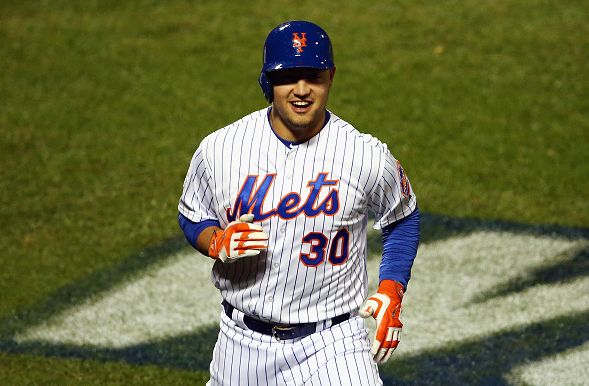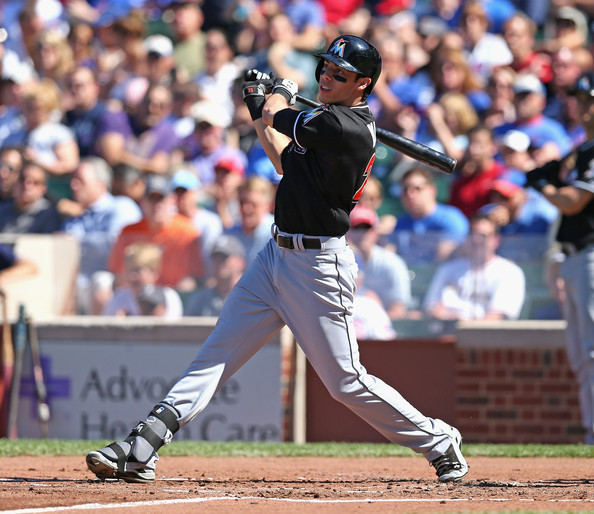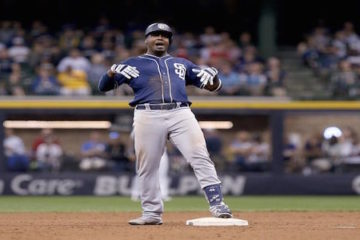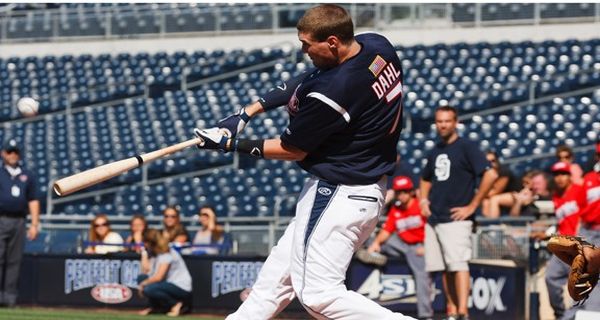Outfielders: Like Him Less, Like Him More

The outfield is deep, and for that reason, it isn’t combined with another position in the Like Him Less, Like Him More series. At shortstop, I chose not to discuss the rankings disparity for Manny Machado as it appeared the result of some rankers not ranking him at that position. The same appears issue appears to be the case with Kris Bryant and Miguel Sano, so I will not be addressing the disparity between my ranking and the expert consensus ranking (ECR). As for who is featured in this piece, one outfielder leaving Colorado finds himself in the Like Him Less section while another who’s inked to start for the Rockies is in the Like Him More section. A pair of sophomore hitters find themselves on opposite ends of the spectrum as well.
Like Him Less
Corey Dickerson – ECR: OF-40, My Rank: OF-75
Hitters have left Colorado and succeeded. It’s unwise to simply take their road production, extrapolate it and assume that’s how the transplanted player will perform. That said, Corey Dickerson’s road production since reaching the majors in 2013 is alarming. In 483 plate appearances away from Colorado, he’s hit just 15 homers with a 5.2% walk rate and 25.7% strikeout rate. Over the last two years, his strikeout rate has been north of 27% on the road. The corner outfielder’s offensive numbers have been greatly enhanced by playing his home games in the thin air of Colorado. His strikeout rate at home was 9% lower than on the road, and his walk rate was 3.4% higher when playing at home. He also swatted nine more homers in Colorado than on the road in 41 fewer plate appearances.
The ballpark shift is less than ideal for Dickerson, but it’s not totally disastrous. Tropicana Field’s left-handed batter park factor of 119 for homers actually bests the 110 factor featured at Coors Field using a rolling three-year average, per StatCorner. Tampa Bay isn’t as friendly a venue for doubles/triples (92 compared to 111 in Colorado) or runs scored (109 in Tampa compared to 135 in Colorado). That said, Tropicana Field does bolster run scoring for lefties, so it’s not exactly a bad ballpark for lefties to hit in. I believe there will be an adjustment period for Dickerson, and his road numbers in his career make him a poor investment at the ECR cost. In long-term keeper leagues and dynasty formats, though, Dickerson makes for an intriguing investment who should be had at a discount as a result of being traded away from Colorado.
Joc Pederson- ECR: OF-42, My Rank: OF-66
Joc Pederson’s full-season line in his rookie year was promising with 26 homers and four stolen bases — albeit saddled by a .210 batting average. The year was a tale of two halves for the left-handed hitting center fielder. In the first half, he ripped 20 homers with a .230 batting average, 15.8% walk rate and 29.2% strikeout rate. In the second half, his walk rate dropped ever so slightly to 15.5% and his strikeout rate improved a bit to 28.8%, but his power evaporated as he hit just six homers and his average cratered to .178.
Digging into his batted ball numbers, Pederson’s line drive rate dropped from 17.1% to 13.6%, his infield fly-ball rate skyrocketed from 10.1% to 22.6% and his hard-hit ball rate took a nosedive from 41.5% to 30.3%, according to FanGraphs. He pulled the ball less frequently in the second half (45.1% pull rate in the first half and 41.2% in the second half). Did Pederson simply wear down or was he unable to adjust when the book got out on him? It’s possible it was a bit of both. Parsing data into halves can be dangerous, but the stark contrast in production is alarming. Perhaps even more alarming is some video evidence of Pederson tinkering this spring. I’m not a swing coach, but Ryan Parker shared a side-by-side GIF of Pederson in the spring compared to him last season that can be seen here. Pederson completely eliminates a leg kick. Parker’s not a fan of the change, and it’s worth following the Twitter discussion about the side-by-side video breakdown tweet. I’ll pass on a hitter who’s clearly trying to make sizable changes at baseball’s highest level.
Like Him More
Gerardo Parra – ECR: OF-49, My Rank: OF-30
It’s often ill-advised to pay the mark up on a player coming off of a career year in their (mostly) age-28 season. However, most players coming off of a career year in their late 20s don’t get thrust into playing home games at Coors Field. Both Miller Park and Camden Yards are great venues for left-handed hitters, but there isn’t a more offensive-friendly venue than Coors Field. Lefties are treated to park factors of 113 for singles, 111 for doubles/triples, 110 for homers and 135 for home runs, per StatCorner. The left-handed hitting outfielder is coming off a year in which he tallied the second lowest strikeout rate (15.6%) in his career, and he paired his reduced strikeout rate with an uptick in fly balls to hit for more power than we’ve previously seen from him and the second highest batting average (.291) of his career.
His new home digs could yield even better production this season. A 2013 article by Dan Rozenson published at Baseball Prospectus analyzed the effect of Coors Field on various pitches. The tables in the article indicate that changeups feature a batting average that’s 39 points higher at Coors Field than at a neutral ballpark, and the ISO gap is even larger. In fact, no pitch is hit harder than the changeup at Coors Field. In a neutral park, changeups yielded a .144 ISO during the time frame of this study, and at Coors Field, that mark surged to .222. Why is that noteworthy? Parra has turned in a positive run value against changeups just one time since reaching the bigs in 2009, and his -12.8 run value for his career against changeups, per FanGraphs, is easily his worst mark against any pitch type. Parra can really punish fastballs, and his penchant for beating up on heaters should play well in Colorado since, as Mike Petriello says “there’s some evidence that pitchers prefer to throw more fastballs in Denver.” Parra should be a positive contributor in all five standard scoring categories and profiles as a strong OF3.
Michael Conforto – ECR: OF-52, My Rank: OF-32
Michael Conforto didn’t need much minor league seasoning before reaching the majors. He was popped with the 10th pick in the 2014 MLB Amateur Draft and played just 133 games in the minors before getting the call up to the show. He raked at every stop, and he made a mostly seamless transition to the majors smacking nine homers with a 8.8% walk rate, 20.1% strikeout rate and .270 batting average in 194 plate appearances for the Mets. New York mostly shielded him from lefties (15 plate appearances against southpaws), but he wasn’t a total train wreck against them in the minors. Last year, in 135 plate appearances against left-handed pitchers in the minors, he recorded a .258/.341/.400 triple-slash line with three homers, a 8.9% walk rate and 16.3% strikeout rate. He’s already flashed impressive hitting skills against righties (nine homers, a .275 batting average, 8.9% walk rate and 20.1% strikeout rate in 179 plate appearances against them in the majors), and being even a bit better than terrible against southpaws would bode well for a hearty full-season overall line.
The sample size is small, but Conforto hit the ball on the screws with regularity in The Show. He tallied a 22.6% line drive rate, and his 40.9% hard-hit ball rate would have ranked tied for fifth highest with Paul Goldschmidt and Bryce Harper if Conforto was a qualified hitter last season. Furthermore, among hitters with 100 at-bats or more, Conforto ranked 18th in average FB/LD exit velocity, per Baseball Savant. The young outfielder’s power also translated in the form of the 85th ranked average home run and fly ball distance (288.94 feet), according to Baseball Heat Maps. Against right-handed pitchers, Conforto should hit in a run producing spot in the order (perhaps as high as third, but likely no worse than fifth or sixth), and his power should allow him to flirt with 25 long balls if he plays everyday.





